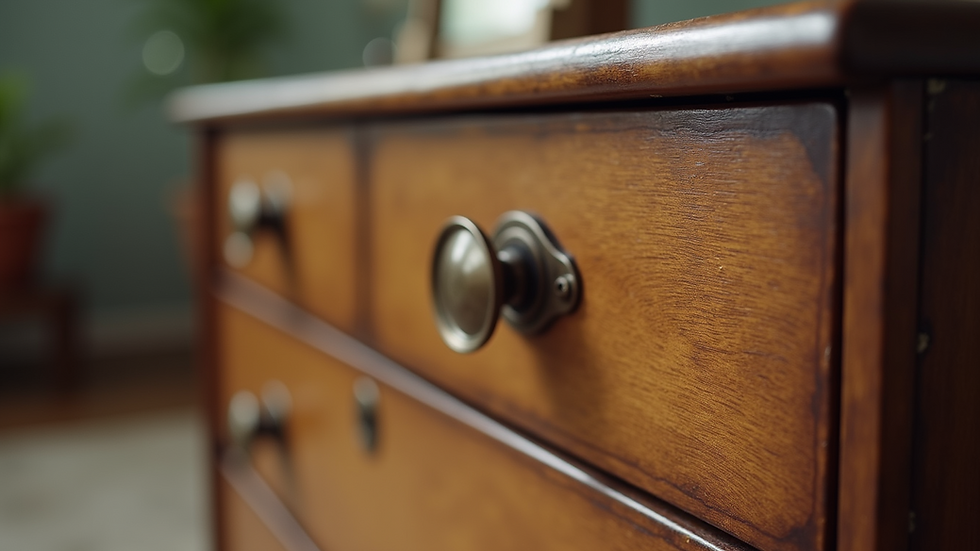How to Identify and Care for Antique Furniture Pieces
- John Wright
- Jun 23
- 3 min read
Antique furniture has a timeless appeal that captures the hearts of collectors and home enthusiasts alike. However, understanding how to identify these pieces and care for them properly can seem daunting. In this guide, we will walk through the essential steps to help you identify antique furniture as well as care for these exquisite pieces over time.
Understanding Antique Furniture
Antique furniture generally refers to items that are at least 100 years old. However, this definition can sometimes vary by context and region. Understanding what characteristics define antique furniture can help you distinguish it from more modern items.
Common materials used include mahogany, walnut, and oak. Furniture from specific periods often feature distinct styles—such as the intricate carvings and gildings of Baroque furniture or the sleek lines of Mid-Century Modern designs.
It’s essential to research the period styles you’re interested in, as each era has its unique features. Many collectors focus on certain styles, such as the Colonial era or Victorian pieces, as these have their historical significance and appeal.

How to Identify Antique Furniture
Identifying antique furniture involves examining key characteristics. First, consider the construction techniques. Many early pieces were handcrafted, which means you may find irregularities and imperfections. Look for signs of hand-planing, mortise-and-tenon joints, and wooden pegs instead of metal fasteners.
Next, check the materials. Authentic antique furniture often uses solid wood rather than plywood or particle board. A simple scratch test can reveal the underlying material. Antique woods often show a unique grain pattern and have an aged patina that modern replicas lack.
Examining hardware, like hinges and drawer pulls, can also provide clues. Older pieces usually feature brass or wrought iron rather than modern, shiny materials. Lastly, the age can sometimes be estimated by examining the finish. Olders pieces tend to have natural oil finishes, while new items often use synthetic varnishes.

Is Antique Furniture Worth Any Money?
When it comes to assessing the value of antique furniture, several factors come into play. Rarity, condition, and provenance are key determinants.
Rarity: Some pieces are harder to find than others, making them more valuable. Limited production items or those from renowned craftsmen often fetch higher prices.
Condition: Furniture that has been well-maintained retains its value significantly better than those in poor shape. Minor refinishing may enhance its appeal, but major alterations can devalue it.
Provenance: The history of ownership can greatly impact value. If a piece belonged to a renowned individual or featured in a historical event, its worth may increase.
Collecting antique furniture can be rewarding both financially and emotionally. It can serve as a fantastic investment, although it's essential to approach purchasing with knowledge and caution to avoid potential pitfalls.
Caring for Antique Furniture
Caring for antique furniture requires special attention to preserve its integrity and appearance. Here are some practical recommendations:
Regular Cleaning
Dusting is crucial, as buildup can scratch the finish. Use a soft, lint-free cloth to gently wipe surfaces. Avoid harsh chemicals that can damage the wood or finishes.
For deeper cleaning, a mixture of mild soap and water can be used. Wipe it down carefully and follow up with a dry cloth to avoid moisture damage.
Control Environmental Factors
Antique furniture is sensitive to temperature and humidity changes. Aim to maintain a stable environment. Ideally, this means keeping rooms at around 70 degrees Fahrenheit with a humidity level of 40-60%. Consider using a humidifier or dehumidifier as needed.
Avoid Direct Sunlight
Prolonged exposure to sunlight can fade and damage wood finishes. Place furniture away from direct sunlight, or use window treatments to limit exposure.

Resealing and Maintenance
Periodically, you may want to reapply beeswax or special wood oils to protect the surface. However, it's essential to do this sparingly to avoid buildup. Follow the manufacturer’s instructions or consult a professional if unsure.
Professional Restoration
If you encounter damage that requires repair, consider hiring a professional conservator who specializes in antique furniture. They possess the expertise needed to restore while preserving the piece's historical integrity.
Final Thoughts on Antique Furniture Preservation
Maintaining antique furniture requires dedication and knowledge, but the rewards are immense. These pieces not only add charm to your home but also connect us to history and craftsmanship that can sometimes feel lost in our fast-paced world. Whether you're a beginner or a seasoned collector, understanding how to care for these treasures ensures they'll be enjoyed for generations.
For further insights and antique furniture pieces, you can explore more here.
Through careful identification and preservation, you can successfully enjoy and appreciate these beautiful items that tell the story of our lives and culture.
.png)



Comments